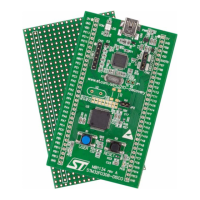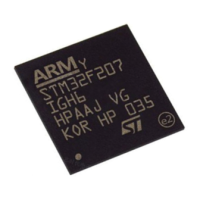Low-, medium-, high- and XL-density reset and clock control (RCC) RM0008
92/1096 Doc ID 13902 Rev 12
External source (HSE bypass)
In this mode, an external clock source must be provided. It can have a frequency of up to
25 MHz. You select this mode by setting the HSEBYP and HSEON
bits in the Clock control
register (RCC_CR). The external clock signal (square, sinus or triangle) with ~50% duty
cycle has to drive the OSC_IN pin while the OSC_OUT pin should be left hi-Z. See Figure 9.
External crystal/ceramic resonator (HSE crystal)
The 4 to 16 MHz external oscillator has the advantage of producing a very accurate rate on
the main clock.
The associated hardware configuration is shown in Figure 9. Refer to the electrical
characteristics section of the datasheet for more details.
The HSERDY flag in the Clock control register (RCC_CR) indicates if the high-speed
external oscillator is stable or not. At startup, the clock is not released until this bit is set by
hardware. An interrupt can be generated if enabled in the Clock interrupt register
(RCC_CIR).
The HSE Crystal can be switched on and off using the HSEON bit in the Clock control
register (RCC_CR).
7.2.2 HSI clock
The HSI clock signal is generated from an internal 8 MHz RC Oscillator and can be used
directly as a system clock or divided by 2 to be used as PLL input.
The HSI RC oscillator has the advantage of providing a clock source at low cost (no external
components). It also has a faster startup time than the HSE crystal oscillator however, even
with calibration the frequency is less accurate than an external crystal oscillator or ceramic
resonator.
Calibration
RC oscillator frequencies can vary from one chip to another due to manufacturing process
variations, this is why each device is factory calibrated by ST for 1% accuracy at T
A
=25°C.
After reset, the factory calibration value is loaded in the HSICAL[7:0] bits in the Clock control
register (RCC_CR).
If the application is subject to voltage or temperature variations this may affect the RC
oscillator speed. You can trim the HSI frequency in the application using the HSITRIM[4:0]
bits in the Clock control register (RCC_CR).
The HSIRDY flag in the Clock control register (RCC_CR) indicates if the HSI RC is stable or
not. At startup, the HSI RC output clock is not released until this bit is set by hardware.
The HSI RC can be switched on and off using the HSION bit in the Clock control register
(RCC_CR).
The HSI signal can also be used as a backup source (Auxiliary clock) if the HSE crystal
oscillator fails. Refer to Section 7.2.7: Clock security system (CSS) on page 94.
7.2.3 PLL
The internal PLL can be used to multiply the HSI RC output or HSE crystal output clock
frequency. Refer to Figure 8 and Clock control register (RCC_CR).

